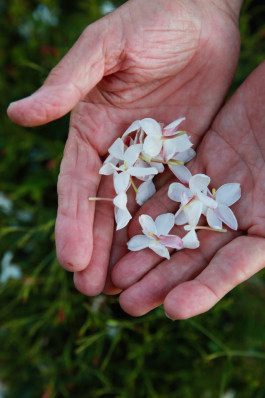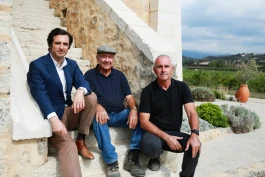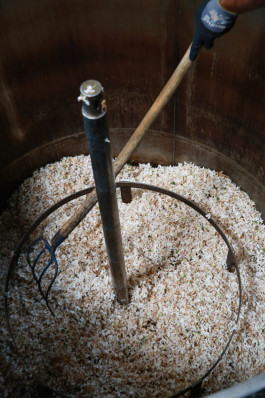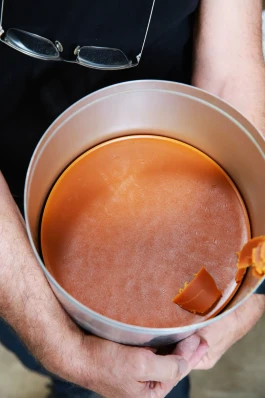FEATURE
When Olivier Polge was succeeding his father, Jacques Polge, as Chanel’s head perfumer, the elder Polge didn’t give his son tactical advice. Instead, he shared the maison’s aromatic history — raison d'être and enigmatic philosophy — that had been passed down by word of mouth by its two previous noses, starting with Ernest Beaux: the perfumer who Gabrielle “Coco” Chanel hired to create Chanel N°5.
“My father told me that Henri Robert (Chanel’s second in-house perfumer) told him, from Ernest Beaux, that when Coco Chanel smelled what was the first trial of N°5, she asked him not which was the best raw material, but which was the most expensive raw material. He said, ‘The jasmine,’ and she said, ‘Add more of that.’ This is why there are about 1,000 jasmine flowers in each bottle of N°5 Eau de Parfum compared to 650 roses,” he recounts.
Over a century later, Chanel’s mandate yields more authority than ever. It continues to define N°5 as the most famous and popular fragrance in the world. It has served as the olfactory blueprint for subsequent Chanel fragrances, and arguably for modern perfumery. And it is also (as a result of my obsession with jasmine perfumes) the reason why I’m talking to the younger Polge in the middle of the Mul family flower fields just outside the village of Pégomas, France — approximately seven miles from the renowned perfume capital of Grasse — at the fragrant height of the annual harvest.

As a child, Polge spent ample time in the area, where his father often worked and where he remembers meeting Joseph Mul, the field’s owner, as a young teen. “My father brought me with him here for lunch, and Joseph had me kill a bird on our first meeting — he’s a great hunter,” Polge recalls with a grin. Despite his pedigree and early introduction to the world of fragrance, Polge studied art history at university before a summer internship in his father’s lab convinced him that perfumery was, a bit surprisingly, his passion as well.
Consequently, Polge spent time at a different company in Grasse learning about raw materials and even handling them. “For a time, I was a worker,” he describes. “I used to start at 6 a.m., loading the extractors with raw material. At that time it was huge pieces of dry moss, higher than me, that we had to crush.” After gaining experience in a variety of companies and countries, including a five-year stint in the United States, Polge joined Chanel in 2013, becoming the fourth nose in the company’s history, nearly a year before his father retired. During their time together at the maison, the elder Polge revealed his take on the identity of Chanel, including the aforementioned origins of Chanel N°5.
I encounter the Mul fields for the first time just before dawn streaks the surrounding valley’s expansive sky and frames tree-topped hills with pastel hues; birdsong mingles with classical music (more on that later); and tidy rows of spindly jasmine plants dappled with tiny, star-like buds punctuated by intense pink centers emit an ethereal, intoxicating fragrance. The indelible aroma peaks at daybreak, lingers in wafts and whiffs, and then trails me for days — both in my sensorial memory and by way of crispy, still-pungent blossoms that fall out of a pocket when I’m unpacking back in the States. Mul had tucked them into my shirt, instructing me to take the scent with me back to America because this delicate yet insistent jasmine, with pronounced green-tea undertones, is specific to the area and to Chanel N°5.

“I see it the same way you would the color palette of a painter,” Polge explains. “It is very important to keep all the pigments correct. The formula for N°5 Eau de Parfum from 1921 always has jasmine from Grasse. It's extremely strong, but not disturbing. There is something perfect — beautiful — that nature can do that we cannot reproduce.” In fact, he goes on to reveal, the perfume’s visionary had quite the opposite goal in mind.
“When Coco Chanel asked Ernest Beaux to create a perfume,” Polge divulges, “she asked for an artificial perfume — a perfume a bit like a dress made of different fabrics that are then shaped by creativity. This is why, when we speak about N°5, we tend to speak about an abstract perfume, which doesn't try to showcase one raw material more than another one. We like very much to shape the raw materials. We never try to reproduce the scent of nature. We try to bend the impression of nature, but in an aesthetic way.”
The other principal “pigments” in the N°5 palette comprise fuchsia-pink rosa centifolia flowers; waxy, lanky tuberose stems; fuzzy, emerald-green geranium leaves; and pendulous iris petals overshadow pungent roots. All are also exclusively grown in the Mul fields. Just like Champagne is only Champagne if it is grown in Champagne, N°5 Eau de Parfum retains its prestige (and quality) thanks to the irreplicable terroir of its ingredients, which have become more and more scarce over the last half-century.
In the 1960s, as the French Riviera gained renown as an international vacation destination, land in Grasse and its surrounds became more valuable for housing than for flower farming, Polge tells me as we meander through the Pégomas field’s ambrosial tapestry. This economic reality coincided with a new generation’s desire to decamp to larger cities, where they could find less physical work and a more dynamic lifestyle. As a result, many perfume companies moved their supply chains to countries where land and labor were cheaper.
The shift threatened Chanel’s supply of Grasse jasmine and, thereby, the integrity of N°5 Eau de Parfum. In 1987, then-house-nose Jacques Polge resolved the quandary by forging an exclusive partnership between Chanel and the Mul family that would secure the quantity and caliber of flowers demanded by the proprietary formula — including not only jasmine but also the rosa centifolia, geranium, iris, and tuberose — at the same time it preserved the environment and ensured a living wage for the family and its workers.

By that time, the Mul family had been farming the fields for four generations, since 1875, when Joseph’s great-grandfather opened a dairy farm that catered to the English and Russian lords who came to Cannes for the winter. In 1895, the perfume boom in Grasse began and the dairy was transformed into flower fields that, through the 1940s, primarily grew mango, geraniums, jasmine, and roses for perfumery, under the leadership of Joseph Mul’s father. Recalling his entry into the family business, Mul simply states, “It was quite natural [that I would take over the farm] because I was my father’s son and my brother was my mother’s son, so I inherited all the habits of my father.” 34 years ago, Mul was joined by his son-in-law Fabrice Bianchi, who married Mul’s daughter, Colette, and whose parents and grandparents farmed mimosa, jasmine, and eucalyptus at family fields just over the hill on a farm now run by Bianchi’s cousin. Colette Mul, her sister, and Mul’s other son-in-law also work in the family business, managing everything from the finances to staff to administration.
The ongoing partnership between the Mul family and Chanel means that the now nearly 75-acre flower farm is a model of progressive, future-forward farming methods pioneered by Bianchi. Beyond its 100% environmentally friendly, organic practices, the farm uses no-till methods. Bianchi has also introduced the use of solar-powered smart probes that measure key environmental factors, maximizing watering efficiencies. Most recently, he has begun projecting classical music over the fields three times a day, at 6:30 a.m., 12:30 p.m., and 6:30 p.m. The experiment is based on findings by the French company Genodics that indicate that certain sound frequencies can prevent and treat plant disease. At daybreak — when accompanied by a waning crescent moon, chiaroscuro floral statues, and scented winds — the soft, disembodied notes also provide the innately cinematic, timeless scene with an apt soundtrack.
During the jasmine harvest, Mul and Bianchi are in the fields every morning, arriving just after the melody subsides. Joseph, whose white-shuttered house overlooks the fields, surveys them upon waking. Fabrice, who lives 20 minutes away, arrives by 7 a.m. to check on the team and the pickers, who squat or bend over the low jasmine rows to hand pluck the fragile flowers top to bottom, dropping each bloom into a wicker basket. By 1 p.m., the pair are in the weighing area, recording each picker’s haul before the day’s harvest is taken to the on-site factory run by Joseph's cousin, Jean-François Vieille, who’s in charge of extraction and distillation, which happen daily during harvest time to ensure the essence of the flowers is fully captured.


Vieille runs the operation with an exhilarating expertise and enthusiasm that is evidenced by his insistence that I sit inside the metal extraction vat while the day’s jasmine harvest is poured in (and over me). It’s probably not an experience currently on anyone’s “bucket list,” but — like nearly every moment I spend in the Mul fields — it should be. Whether being wrapped in a cloud-like blanket of jasmine blossoms; listening to the gentle hum of cicadas in the chilly wee hours, under the light of the morning’s tenacious last stars; or, weeks later, sniffing the stopper of a bottle of Chanel N°5 Eau de Parfum, I am reminded of nature’s simple, refined elegance.
It is precisely this experience, this spirit, that the Mul family endeavors to capture with their flowers and which Polge and his predecessors transform into an artistic, subjective expression that, similar to a successful portrait, magically encapsulates both a precise moment in time and the enduring essence of its subject.
PUBLISHED IN DEPARTURES
PHOTOGRAPHY BY SKYE PARROTT
view more
FEATURE
When Olivier Polge was succeeding his father, Jacques Polge, as Chanel’s head perfumer, the elder Polge didn’t give his son tactical advice. Instead, he shared the maison’s aromatic history — raison d'être and enigmatic philosophy — that had been passed down by word of mouth by its two previous noses, starting with Ernest Beaux: the perfumer who Gabrielle “Coco” Chanel hired to create Chanel N°5.
“My father told me that Henri Robert (Chanel’s second in-house perfumer) told him, from Ernest Beaux, that when Coco Chanel smelled what was the first trial of N°5, she asked him not which was the best raw material, but which was the most expensive raw material. He said, ‘The jasmine,’ and she said, ‘Add more of that.’ This is why there are about 1,000 jasmine flowers in each bottle of N°5 Eau de Parfum compared to 650 roses,” he recounts.
Over a century later, Chanel’s mandate yields more authority than ever. It continues to define N°5 as the most famous and popular fragrance in the world. It has served as the olfactory blueprint for subsequent Chanel fragrances, and arguably for modern perfumery. And it is also (as a result of my obsession with jasmine perfumes) the reason why I’m talking to the younger Polge in the middle of the Mul family flower fields just outside the village of Pégomas, France — approximately seven miles from the renowned perfume capital of Grasse — at the fragrant height of the annual harvest.

As a child, Polge spent ample time in the area, where his father often worked and where he remembers meeting Joseph Mul, the field’s owner, as a young teen. “My father brought me with him here for lunch, and Joseph had me kill a bird on our first meeting — he’s a great hunter,” Polge recalls with a grin. Despite his pedigree and early introduction to the world of fragrance, Polge studied art history at university before a summer internship in his father’s lab convinced him that perfumery was, a bit surprisingly, his passion as well.
Consequently, Polge spent time at a different company in Grasse learning about raw materials and even handling them. “For a time, I was a worker,” he describes. “I used to start at 6 a.m., loading the extractors with raw material. At that time it was huge pieces of dry moss, higher than me, that we had to crush.” After gaining experience in a variety of companies and countries, including a five-year stint in the United States, Polge joined Chanel in 2013, becoming the fourth nose in the company’s history, nearly a year before his father retired. During their time together at the maison, the elder Polge revealed his take on the identity of Chanel, including the aforementioned origins of Chanel N°5.
I encounter the Mul fields for the first time just before dawn streaks the surrounding valley’s expansive sky and frames tree-topped hills with pastel hues; birdsong mingles with classical music (more on that later); and tidy rows of spindly jasmine plants dappled with tiny, star-like buds punctuated by intense pink centers emit an ethereal, intoxicating fragrance. The indelible aroma peaks at daybreak, lingers in wafts and whiffs, and then trails me for days — both in my sensorial memory and by way of crispy, still-pungent blossoms that fall out of a pocket when I’m unpacking back in the States. Mul had tucked them into my shirt, instructing me to take the scent with me back to America because this delicate yet insistent jasmine, with pronounced green-tea undertones, is specific to the area and to Chanel N°5.

“I see it the same way you would the color palette of a painter,” Polge explains. “It is very important to keep all the pigments correct. The formula for N°5 Eau de Parfum from 1921 always has jasmine from Grasse. It's extremely strong, but not disturbing. There is something perfect — beautiful — that nature can do that we cannot reproduce.” In fact, he goes on to reveal, the perfume’s visionary had quite the opposite goal in mind.
“When Coco Chanel asked Ernest Beaux to create a perfume,” Polge divulges, “she asked for an artificial perfume — a perfume a bit like a dress made of different fabrics that are then shaped by creativity. This is why, when we speak about N°5, we tend to speak about an abstract perfume, which doesn't try to showcase one raw material more than another one. We like very much to shape the raw materials. We never try to reproduce the scent of nature. We try to bend the impression of nature, but in an aesthetic way.”
The other principal “pigments” in the N°5 palette comprise fuchsia-pink rosa centifolia flowers; waxy, lanky tuberose stems; fuzzy, emerald-green geranium leaves; and pendulous iris petals overshadow pungent roots. All are also exclusively grown in the Mul fields. Just like Champagne is only Champagne if it is grown in Champagne, N°5 Eau de Parfum retains its prestige (and quality) thanks to the irreplicable terroir of its ingredients, which have become more and more scarce over the last half-century.
In the 1960s, as the French Riviera gained renown as an international vacation destination, land in Grasse and its surrounds became more valuable for housing than for flower farming, Polge tells me as we meander through the Pégomas field’s ambrosial tapestry. This economic reality coincided with a new generation’s desire to decamp to larger cities, where they could find less physical work and a more dynamic lifestyle. As a result, many perfume companies moved their supply chains to countries where land and labor were cheaper.
The shift threatened Chanel’s supply of Grasse jasmine and, thereby, the integrity of N°5 Eau de Parfum. In 1987, then-house-nose Jacques Polge resolved the quandary by forging an exclusive partnership between Chanel and the Mul family that would secure the quantity and caliber of flowers demanded by the proprietary formula — including not only jasmine but also the rosa centifolia, geranium, iris, and tuberose — at the same time it preserved the environment and ensured a living wage for the family and its workers.

By that time, the Mul family had been farming the fields for four generations, since 1875, when Joseph’s great-grandfather opened a dairy farm that catered to the English and Russian lords who came to Cannes for the winter. In 1895, the perfume boom in Grasse began and the dairy was transformed into flower fields that, through the 1940s, primarily grew mango, geraniums, jasmine, and roses for perfumery, under the leadership of Joseph Mul’s father. Recalling his entry into the family business, Mul simply states, “It was quite natural [that I would take over the farm] because I was my father’s son and my brother was my mother’s son, so I inherited all the habits of my father.” 34 years ago, Mul was joined by his son-in-law Fabrice Bianchi, who married Mul’s daughter, Colette, and whose parents and grandparents farmed mimosa, jasmine, and eucalyptus at family fields just over the hill on a farm now run by Bianchi’s cousin. Colette Mul, her sister, and Mul’s other son-in-law also work in the family business, managing everything from the finances to staff to administration.
The ongoing partnership between the Mul family and Chanel means that the now nearly 75-acre flower farm is a model of progressive, future-forward farming methods pioneered by Bianchi. Beyond its 100% environmentally friendly, organic practices, the farm uses no-till methods. Bianchi has also introduced the use of solar-powered smart probes that measure key environmental factors, maximizing watering efficiencies. Most recently, he has begun projecting classical music over the fields three times a day, at 6:30 a.m., 12:30 p.m., and 6:30 p.m. The experiment is based on findings by the French company Genodics that indicate that certain sound frequencies can prevent and treat plant disease. At daybreak — when accompanied by a waning crescent moon, chiaroscuro floral statues, and scented winds — the soft, disembodied notes also provide the innately cinematic, timeless scene with an apt soundtrack.
During the jasmine harvest, Mul and Bianchi are in the fields every morning, arriving just after the melody subsides. Joseph, whose white-shuttered house overlooks the fields, surveys them upon waking. Fabrice, who lives 20 minutes away, arrives by 7 a.m. to check on the team and the pickers, who squat or bend over the low jasmine rows to hand pluck the fragile flowers top to bottom, dropping each bloom into a wicker basket. By 1 p.m., the pair are in the weighing area, recording each picker’s haul before the day’s harvest is taken to the on-site factory run by Joseph's cousin, Jean-François Vieille, who’s in charge of extraction and distillation, which happen daily during harvest time to ensure the essence of the flowers is fully captured.


Vieille runs the operation with an exhilarating expertise and enthusiasm that is evidenced by his insistence that I sit inside the metal extraction vat while the day’s jasmine harvest is poured in (and over me). It’s probably not an experience currently on anyone’s “bucket list,” but — like nearly every moment I spend in the Mul fields — it should be. Whether being wrapped in a cloud-like blanket of jasmine blossoms; listening to the gentle hum of cicadas in the chilly wee hours, under the light of the morning’s tenacious last stars; or, weeks later, sniffing the stopper of a bottle of Chanel N°5 Eau de Parfum, I am reminded of nature’s simple, refined elegance.
It is precisely this experience, this spirit, that the Mul family endeavors to capture with their flowers and which Polge and his predecessors transform into an artistic, subjective expression that, similar to a successful portrait, magically encapsulates both a precise moment in time and the enduring essence of its subject.
PUBLISHED IN DEPARTURES
PHOTOGRAPHY BY SKYE PARROTT
view more